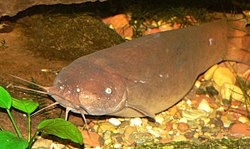Electric catfish: Difference between revisions
| Line 21: | Line 21: | ||
Malapteruridae is the only group of catfish with a well-developed electrogenic organ; however, electroreceptive systems are widespread in catfishes.<ref name="Howes"/> The electrogenic organ is derived from anterior body musculature and lines the body cavity.<ref name="Nelson">{{cite book|title=[[Fishes of the World]]|last=Nelson|first=Joseph S.|publisher=[[John Wiley & Sons]], Inc|year=2006|isbn=0-471-25031-7}}</ref> Electric catfish do not have dorsal fins or fin spines. They have three pairs of barbels (the nasal pair is absent).<ref name="Nelson"/> The [[gas bladder|swim bladder]] with elongate posterior chambers, two chambers in ''Malapterrus'' and three in ''Paradoxoglanis''.<ref name="Nelson"/> |
Malapteruridae is the only group of catfish with a well-developed electrogenic organ; however, electroreceptive systems are widespread in catfishes.<ref name="Howes"/> The electrogenic organ is derived from anterior body musculature and lines the body cavity.<ref name="Nelson">{{cite book|title=[[Fishes of the World]]|last=Nelson|first=Joseph S.|publisher=[[John Wiley & Sons]], Inc|year=2006|isbn=0-471-25031-7}}</ref> Electric catfish do not have dorsal fins or fin spines. They have three pairs of barbels (the nasal pair is absent).<ref name="Nelson"/> The [[gas bladder|swim bladder]] with elongate posterior chambers, two chambers in ''Malapterrus'' and three in ''Paradoxoglanis''.<ref name="Nelson"/> |
||
They can grow as large as 100 [[centimetre]]s (39 [[inch|in]]) [[fish measurement|SL]] and about 20 [[kilogram]]s (44 [[pound (mass)|lb]]) in [[weight]].<ref name="Nelson"/><ref name="Ng">{{cite web|url=http://animaldiversity.ummz.umich.edu/site/accounts/information/Malapterurus_electricus.html|first=Heok Hee|last=Ng|title=''Malapterurus electricus''|publisher=Animal Diversity Web|year=2000|accessdate=2007-07-28}}</ref> All ''Paradoxoglanis'' species are much smaller.<ref name="Nelson"/> Most malapterurids are dwarf species less than 30 cm (12 inches) long. |
They can grow as large as 100 [[centimetre]]s (39 [[inch|in]]) [[fish measurement|SL]] and about 20 [[kilogram]]s (44 [[pound (mass)|lb]]) in [[weight]].<ref name="Nelson"/><ref name="Ng">{{cite web|url=http://animaldiversity.ummz.umich.edu/site/accounts/information/Malapterurus_electricus.html|first=Heok Hee|last=Ng|title=''Malapterurus electricus''|publisher=Animal Diversity Web|year=2000|accessdate=2007-07-28}}</ref> All ''Paradoxoglanis'' species are much smaller.<ref name="Nelson"/> Most malapterurids are dwarf species less than 30 cm (12 inches) long.iiiiiiiiiiiiiiiiiiiiiiiiiiiiiiiiiiiiiiiiiiiiiiiiiiiiiiiiiiiiiiiiiiiiiiiiiiiiiiiiiiiiiiiiiiiiii |
||
==Relationship to humans== |
==Relationship to humans== |
||
Revision as of 20:59, 25 November 2008
| Electric catfish | |
|---|---|

| |
| Malapterurus electricus | |
| Scientific classification | |
| Kingdom: | |
| Phylum: | |
| Class: | |
| Order: | |
| Family: | Malapteruridae Bleeker, 1858
|
| Genera | |
Electric catfish is the common name for the catfish (order Siluriformes) family Malapteruridae. This family includes two genera, Malapterurus and Paradoxoglanis with 19 species.[1] Several species of this family have the ability to produce an electric shock of up to 350 volts using electroplaques of an electric organ.[2] Electric catfish are found in tropical Africa and the Nile River.[3] Electric catfish are usually nocturnal and feed primarily on other fish, incapacitating their prey with electric discharges.[2]
Description
Malapteruridae is the only group of catfish with a well-developed electrogenic organ; however, electroreceptive systems are widespread in catfishes.[4] The electrogenic organ is derived from anterior body musculature and lines the body cavity.[3] Electric catfish do not have dorsal fins or fin spines. They have three pairs of barbels (the nasal pair is absent).[3] The swim bladder with elongate posterior chambers, two chambers in Malapterrus and three in Paradoxoglanis.[3]
They can grow as large as 100 centimetres (39 in) SL and about 20 kilograms (44 lb) in weight.[3][2] All Paradoxoglanis species are much smaller.[3] Most malapterurids are dwarf species less than 30 cm (12 inches) long.iiiiiiiiiiiiiiiiiiiiiiiiiiiiiiiiiiiiiiiiiiiiiiiiiiiiiiiiiiiiiiiiiiiiiiiiiiiiiiiiiiiiiiiiiiiiii
Relationship to humans
The Nile fish was well known to the ancient Egyptians. The Egyptians have depicted the fish in their mural paintings and elsewhere; the first extant depiction of an electric catfish is that on the slate pallete of the pre-dynastic Egyptian ruler Narmer, about 3100 BC.[4] An account of its electric properties was given by an Arab physician of the 12th century; then as now the fish was known by the suggestive name of Raad or Raash, which means thunder (literally trembler, shaker).
The shock an electric catfish can generate is not known to be fatal to humans.[2] the catfish uses its electricity as a weapon to warn of predators Saturday Night Live
Popular culture
The Animal Planet episode "The Future Is Wild" introduced the lurkfish, a theoretical descendant of the electric catfish in 1,000,000 years in the future, which has a much more powerful electric shock that it uses as an active weapon.
References
This article incorporates text from a publication now in the public domain: Chisholm, Hugh, ed. (1911). Encyclopædia Britannica (11th ed.). Cambridge University Press. {{cite encyclopedia}}: Missing or empty |title= (help)
- ^ Ferraris, Carl J., Jr. (2007). "Checklist of catfishes, recent and fossil (Osteichthyes: Siluriformes), and catalogue of siluriform primary types" (PDF). Zootaxa. 1418: 1–628.
{{cite journal}}: CS1 maint: multiple names: authors list (link) - ^ a b c d Ng, Heok Hee (2000). "Malapterurus electricus". Animal Diversity Web. Retrieved 2007-07-28.
- ^ a b c d e f Nelson, Joseph S. (2006). Fishes of the World. John Wiley & Sons, Inc. ISBN 0-471-25031-7.
- ^ a b Howes, George J. (1985). "The phylogenetic relationships of the electric catfish family Malapteruridae (Teleostei: Siluroidei)". Journal of Natural History. 19: 37–67. doi:10.1080/00222938500770031.
